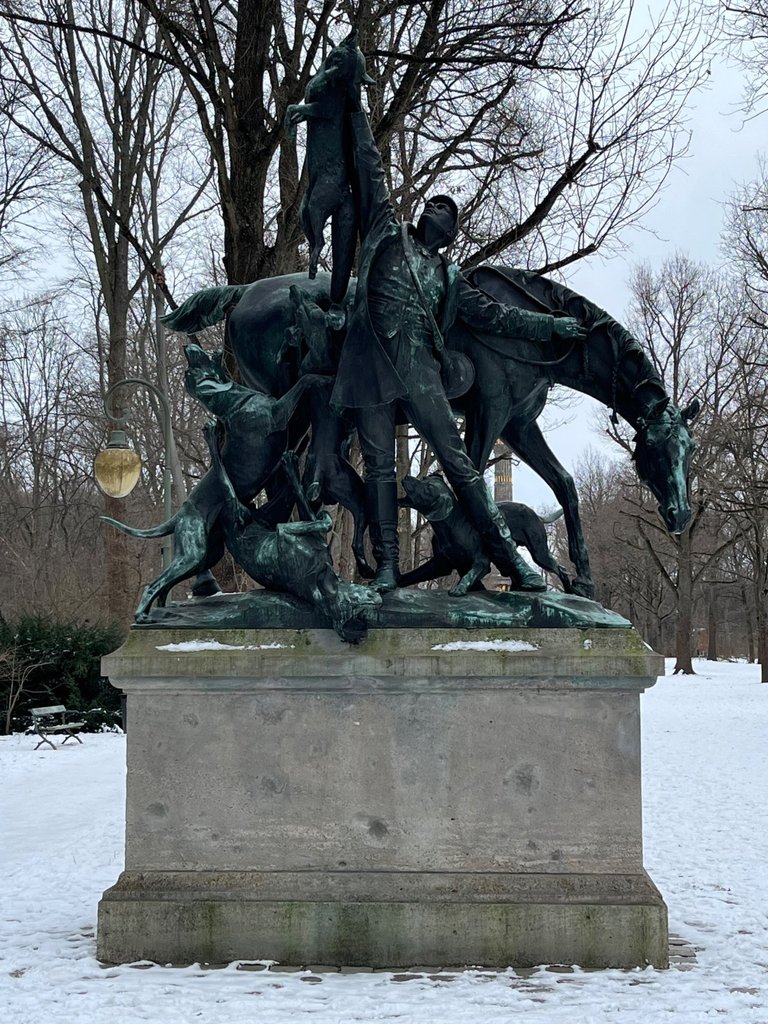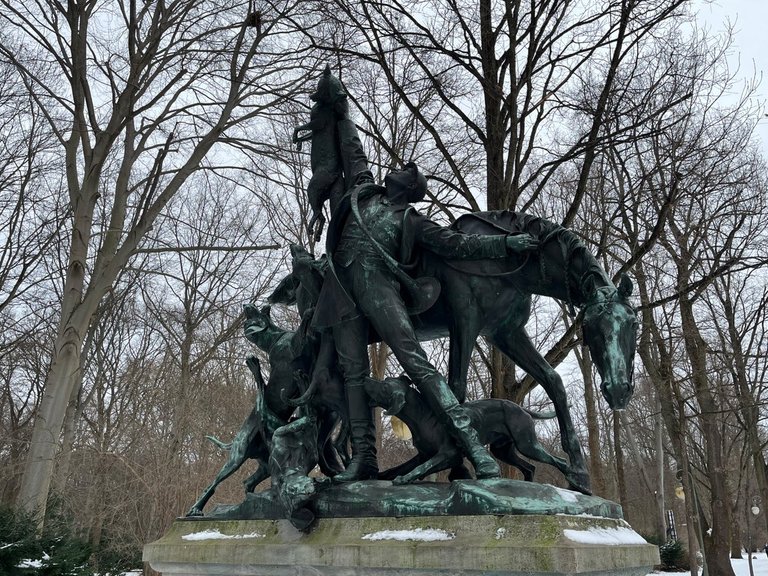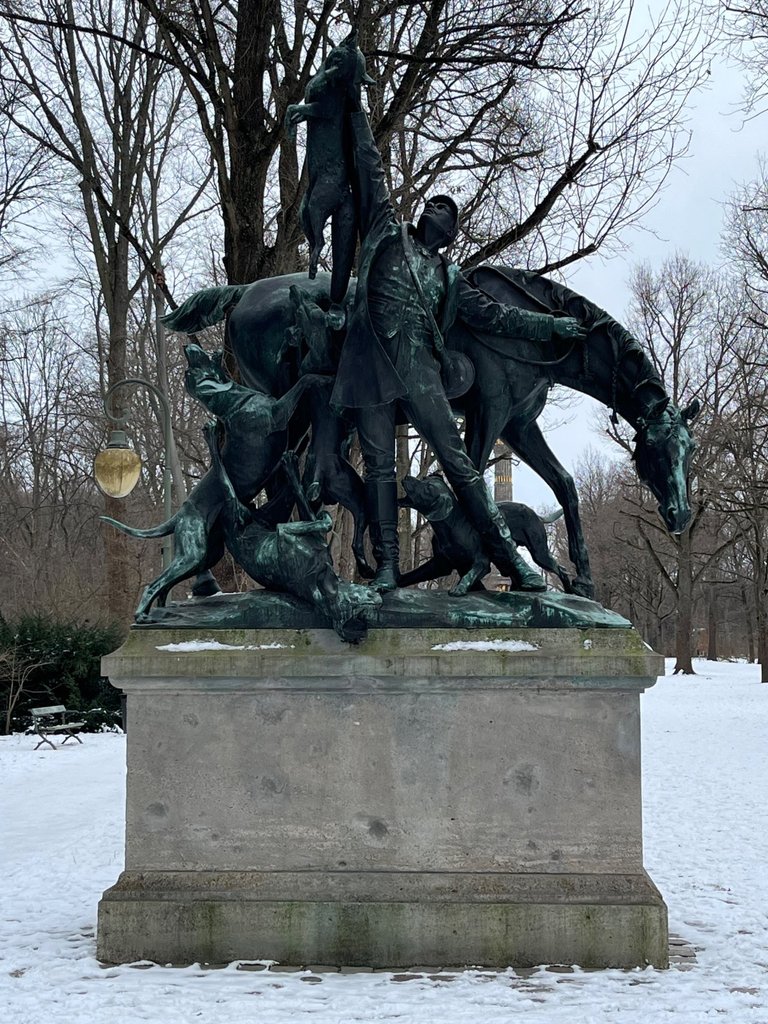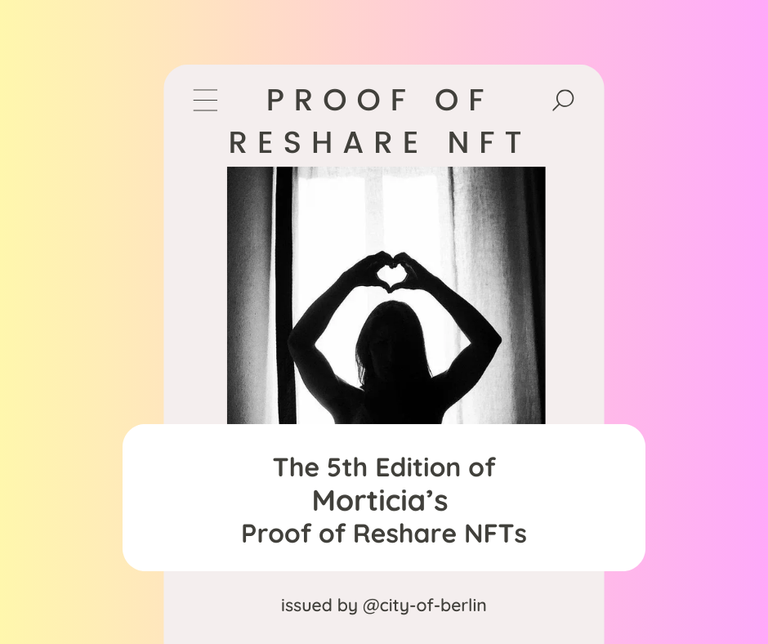Hello, dear readers! It's Morticia here, bringing you another fascinating piece from my winter walk a little while back. Today I would like to introduce you to a fascinating sculpture I stumbled across in the Fasanerieallee in Berlin's Tiergarten. The sculpture is called "Fox Hunting in the Imperial Era" and offers a fascinating insight into both art history and social values at the time.
Description and artistic context
The "Fox Hunt in the Imperial Era" is an impressive work by the well-known sculptor Wilhelm Haverkamp. Haverkamp, who is known for his realistic style and attention to detail, completed this work at the beginning of the 20th century. The sculpture depicts a scene from a traditional fox hunt, a popular pastime in the German Reich. The hunter proudly presents the shot fox, accompanied by his hounds, who are excitedly romping around the scene. Standing in front of the sculpture, you can't help but be drawn into the dynamic movement captured in bronze. Although the horse looks up somewhat languidly from its grazing, it forms a calm backdrop to the dogs caught up in the frenzy of the hunt. Haverkamp's ability to depict action and emotion so vividly is testament to his skill and deep understanding of human and animal anatomy.
Historical and stylistic context

Wilhelm Haverkamp was a prominent figure in the German art scene of the late 19th and early 20th centuries. His works are often in the tradition of historical realism, characterized by detailed, lifelike depictions and dramatic compositions. The "Fox Hunt in Imperial Times" is no exception. It embodies the fascination of the time for hunting and outdoor sports and is intended to evoke a sense of the thrill associated with these activities. The sculpture fits into the broader historical context of the German Empire, where hunting was not only a sport but also a symbol of status and power. It reflects the artistic trends of the era, which often glorified the nobility and their activities and portrayed them in an idealized light.
Effect and criticism
When I saw this sculpture in the tranquil surroundings of the Tiergarten, I was struck by the contrast between the peaceful environment and the rather violent scene depicted. This juxtaposition makes us think about our historical relationship to animals and nature. The depiction of the fox hunt is undeniably dramatic and artistically impressive, but it also brings to light the often brutal reality of such chases. In today's context, such a scene can be disturbing as it illustrates a form of violence that many today see as unnecessary and cruel. It reminds us of how far we have come in our understanding of animal rights and the importance of conservation. The sculpture captures a historical moment, but also invites us to reflect on our current and future relationships with wildlife.

Looking to the future
As I stood there looking at the "Fox Hunt in Imperial Times", I felt a mixture of admiration for Haverkamp's artistic skill and hope for a future in which the scenes we commemorate are characterized by harmony rather than conflict. I hope that over time our relationship with animals will continue to evolve towards mutual respect and care. While this sculpture is rooted in a historical narrative, it can serve as a powerful symbol for change. It reminds us of our past, challenges us to think critically about our present, and inspires us to envision a future where humans and animals coexist peacefully.
Thank you for joining me on this thoughtful journey. I encourage you all to visit the zoo and experience this work for yourself. Until next time, let's continue to explore and reflect on the art and history that shapes our world.
Ciao Kakao,
Your Morticia
Ein weiterer Spaziergang durch die Geschichte: Die Skulptur "Fuchsjagd zur Kaiserzeit" im Tiergarten, Berlin
Hallo, liebe Leser! Hier ist Morticia und bringt euch ein weiteres faszinierendes Stück von meinem Winterspaziergang, der schon etwas länger zurückliegt. Heute möchte ich euch eine faszinierende Skulptur vorstellen, über die ich in der Fasanerieallee im Berliner Tiergarten gestolpert bin. Die Skulptur trägt den Namen "Fuchsjagd zur Kaiserzeit" und bietet einen fesselnden Einblick sowohl in die Kunstgeschichte als auch in die gesellschaftliche Werte zu dieser Zeit.
Beschreibung und künstlerischer Kontext
Die "Fuchsjagd zur Kaiserzeit" ist ein eindrucksvolles Werk des bekannten Bildhauers Wilhelm Haverkamp. Haverkamp, der für seinen realistischen Stil und seine Liebe zum Detail bekannt ist, stellte dieses Werk Anfang des 20. Jahrhunderts fertig. Die Skulptur stellt eine Szene aus einer traditionellen Fuchsjagd dar, einem beliebten Zeitvertreib im Deutschen Reich. Der Jäger präsentiert stolz den erlegten Fuchs, begleitet von seinen Hunden, die aufgeregt durch die Szenerie tollen. Wenn man vor der Skulptur steht, kann man nicht anders, als in die dynamische, in Bronze festgehaltene Bewegung hineingezogen zu werden. Das Pferde schaut zwar etwas träge vom grasen auf, bildet aber dadurch den ruhenden Hintergrund vor den im Rausch der Jagd gefangen Hunde. Haverkamps Fähigkeit, Handlung und Emotionen so anschaulich darzustellen, zeugt von seinem Können und seinem tiefen Verständnis der menschlichen und tierischen Anatomie.
Historischer und stilistischer Kontext

Wilhelm Haverkamp war eine prominente Figur in der deutschen Kunstszene des späten 19. und frühen 20. Jahrhunderts. Seine Werke stehen häufig in der Tradition des historischen Realismus, der sich durch detaillierte, naturgetreue Darstellungen und dramatische Kompositionen auszeichnet. Die "Fuchsjagd zur Kaiserzeit" ist keine Ausnahme. Sie verkörpert die Faszination der damaligen Zeit für die Jagd und den Sport in der freien Natur und soll ein Gefühl für den Nervenkitzel, der mit diesen Aktivitäten verbunden ist, hervorrufen. Die Skulptur fügt sich in den breiteren historischen Kontext des Deutschen Reiches ein, in dem die Jagd nicht nur ein Sport, sondern auch ein Symbol für Status und Macht war. Sie spiegelt die künstlerischen Tendenzen der Epoche wider, die den Adel und seine Aktivitäten oft verherrlichten und in einem idealisierten Licht darstellten.
Wirkung und Kritik
Als ich diese Skulptur in der ruhigen Umgebung des Tiergartens sah, war ich beeindruckt von dem Kontrast zwischen der ruhigen Umgebung und der dargestellten doch recht gewalttätigen Szene. Diese Gegenüberstellung regt zum Nachdenken über unser historisches Verhältnis zu Tier und Natur an. Die Darstellung der Fuchsjagd ist unbestreitbar dramatisch und künstlerisch beeindruckend, aber sie bringt auch die oft brutale Realität solcher Verfolgungsjagden ans Licht. Im heutigen Kontext kann eine solche Szene beunruhigend sein, da sie eine Form der Gewalt verdeutlicht, die viele heute als unnötig und grausam ansehen. Sie erinnert uns daran, wie weit wir in unserem Verständnis von Tierrechten und der Bedeutung des Naturschutzes gekommen sind. Die Skulptur hält einen historischen Moment fest, lädt aber auch dazu ein, über unsere gegenwärtigen und zukünftigen Beziehungen zur Tierwelt nachzudenken.

Blick in die Zukunft
Als ich dort stand und die "Fuchsjagd zur Kaiserzeit" betrachtete, empfand ich eine Mischung aus Bewunderung für Haverkamps künstlerisches Können und Hoffnung auf eine Zukunft, in der die Szenen, derer wir gedenken, von Harmonie und nicht von Konflikt geprägt sind. Ich hoffe, dass sich unsere Beziehung zu Tieren im Laufe der Zeit weiter in Richtung gegenseitiger Achtung und Fürsorge entwickeln wird. Diese Skulptur ist zwar in einer historischen Erzählung verwurzelt, kann aber als kraftvolles Symbol für den Wandel dienen. Sie erinnert uns an unsere Vergangenheit, fordert uns auf, kritisch über unsere Gegenwart nachzudenken, und inspiriert uns, uns eine Zukunft vorzustellen, in der Menschen und Tiere friedlich koexistieren.
Vielen Dank, dass Ihr mich auf dieser nachdenklichen Reise begleiten. Ich möchte Euch alle ermutigen, den Tiergarten zu besuchen und dieses Werk selbst zu erleben. Bis zum nächsten Mal, lasst uns weiter die Kunst und die Geschichte, die unsere Welt prägen, erforschen und darüber nachdenken.
Ciao Kakao,
Eure Morticia
 |  |  |
| Don't forget to reshare! | For every reshare/rehive you will get one of my Proof-of-Reshare NFTs. Current Edition: Morticia #4 only 30 pices | Don't forget to reshare! |
Nice piece and beautiful statue!
Just want to say something about this:
In today's context, such a scene can be disturbing as it illustrates a form of violence that many today see as unnecessary and cruel. It reminds us of how far we have come in our understanding of animal rights and the importance of conservation.
I think in today's context, some people just want to be against everything and exaggerate too much. I believe one doesn't need to be a tree-cuddler to like the nature and someone who hunts foxes isn't necessarily against animals or animal rights (which is an exaggerated term already...
Congratulations, your post has been added to Pinmapple! 🎉🥳🍍
Did you know you have your own profile map?
And every post has their own map too!
Want to have your post on the map too?
Congratulations @city-of-berlin! You received the biggest smile and some love from TravelFeed! Keep up the amazing blog. 😍 Your post was also chosen as top pick of the day and is now featured on the TravelFeed front page.
Thanks for using TravelFeed!
@for91days (TravelFeed team)
PS: Did you know that we recently launched the truvvl app? With truvvl, you can create travel stories on the go from your phone and swipe through nearby stories from other TravelFeed users. It is available on the Apple App Store and Google Play.